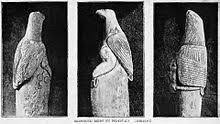Symbolism of the soapstone birds at Great Zimbabwe
Elizabeth
Duve Dziva
Duve Dziva
Over the years,
interest in and understanding of African symbols and their meanings has greatly
increased with contemporary research doing much to destroy earlier myths,
correct distortions and add knowledge of Africa’s vast, varied and thrilling past.
interest in and understanding of African symbols and their meanings has greatly
increased with contemporary research doing much to destroy earlier myths,
correct distortions and add knowledge of Africa’s vast, varied and thrilling past.
The soapstone birds at
Great Zimbabwe mean much more than any description of the relics found at the prehistoric
city of theVaShona. Apart from their aesthetic appearance, the soapstone birds
are visibly symbolic that even the settler government that ruled the country
for 90 years could not resist their powerful symbolism.
Great Zimbabwe mean much more than any description of the relics found at the prehistoric
city of theVaShona. Apart from their aesthetic appearance, the soapstone birds
are visibly symbolic that even the settler government that ruled the country
for 90 years could not resist their powerful symbolism.
A total of seven
soapstone birds were found in and around the monument. It still remains a
controversial issue as to which bird is represented by the carvings. Some want
to believe that it represents the bateleur eagle (chapungu) while some want to
believe that it represents the fish eagle (hungwe shirichena). Both birds are
significant in the African religion. Both bird’s physical representation
symbolises communication between the state and spirits of the land, a
relationship vital to humanity. The bateleur
eagle flies to greater heights than any other bird hence the VaShona developed
a belief that it was a messenger of God.
soapstone birds were found in and around the monument. It still remains a
controversial issue as to which bird is represented by the carvings. Some want
to believe that it represents the bateleur eagle (chapungu) while some want to
believe that it represents the fish eagle (hungwe shirichena). Both birds are
significant in the African religion. Both bird’s physical representation
symbolises communication between the state and spirits of the land, a
relationship vital to humanity. The bateleur
eagle flies to greater heights than any other bird hence the VaShona developed
a belief that it was a messenger of God.
During the liberation
struggle, appearance of the bateleur eagle would warn and signal danger to the
freedom fighters. Divergently, the fish eagle (hungwe shirichena), is of
religious significance not only in totemism. Its vitality extends to royalty at
Great Zimbabwe. Symbolic are also the crocodile and chevron motifs on the birds
which are equally associated with sacredness and royalty.
struggle, appearance of the bateleur eagle would warn and signal danger to the
freedom fighters. Divergently, the fish eagle (hungwe shirichena), is of
religious significance not only in totemism. Its vitality extends to royalty at
Great Zimbabwe. Symbolic are also the crocodile and chevron motifs on the birds
which are equally associated with sacredness and royalty.
All, except one bird
which is the national emblem of Zimbabwe were taken to South Africa, German and
Austria at the end of the 19th century. The one which was exported
to South Africa is still in the collection in Groote Schuur Museum. Reports are
that it was found in Cecil John Rhodes’ bedroom. The former president of
Zimbabwe Robert Mugabe is quoted saying “totemless people” referring to white
men but Cecil John Rhodes became the first and last unique white men as it is
orally reported that he had fallen in love with the soapstone bird that he made
it his personal totem. Consequently, a replica
was made to represent the former and place in the bird gallery at Great
Zimbabwe Museum.
which is the national emblem of Zimbabwe were taken to South Africa, German and
Austria at the end of the 19th century. The one which was exported
to South Africa is still in the collection in Groote Schuur Museum. Reports are
that it was found in Cecil John Rhodes’ bedroom. The former president of
Zimbabwe Robert Mugabe is quoted saying “totemless people” referring to white
men but Cecil John Rhodes became the first and last unique white men as it is
orally reported that he had fallen in love with the soapstone bird that he made
it his personal totem. Consequently, a replica
was made to represent the former and place in the bird gallery at Great
Zimbabwe Museum.
Matenga is quoted
saying the birds are an ideogram symbolising historical continuity of a strong
spirituality from ancient to modern times. They are an icon of sovereign
nationhood inscribed on the National Coat of Arms. One of the birds is on the
national flag and an emblem of the collective will to build the nation through
spiritual, socio political and economic endeavor. The birds are not just antique
collection as they constitute a living tradition that is valuable to
Zimbabweans.
saying the birds are an ideogram symbolising historical continuity of a strong
spirituality from ancient to modern times. They are an icon of sovereign
nationhood inscribed on the National Coat of Arms. One of the birds is on the
national flag and an emblem of the collective will to build the nation through
spiritual, socio political and economic endeavor. The birds are not just antique
collection as they constitute a living tradition that is valuable to
Zimbabweans.
Regardless of the value
of the soapstone birds depicted beyond reasonable doubt, descendants of the Sculptors
have turned a blind eye to the spirituality associated with the birds. They
have rather been placed in galleries for foreigners to view in exchange for
money. Surprisingly, that has not in any way improved the economy, a sign that
there is something amiss. It is time
Zimbabweans decolonise their minds and value what needs be valued.
of the soapstone birds depicted beyond reasonable doubt, descendants of the Sculptors
have turned a blind eye to the spirituality associated with the birds. They
have rather been placed in galleries for foreigners to view in exchange for
money. Surprisingly, that has not in any way improved the economy, a sign that
there is something amiss. It is time
Zimbabweans decolonise their minds and value what needs be valued.
Elizabeth
Duve Dziva is an Archaeologist and cultural Heritage practitioner. The views in
this article are solely hers and do not represent those of any organization. Email
du***********@gm***.com
Duve Dziva is an Archaeologist and cultural Heritage practitioner. The views in
this article are solely hers and do not represent those of any organization. Email
du***********@gm***.com







